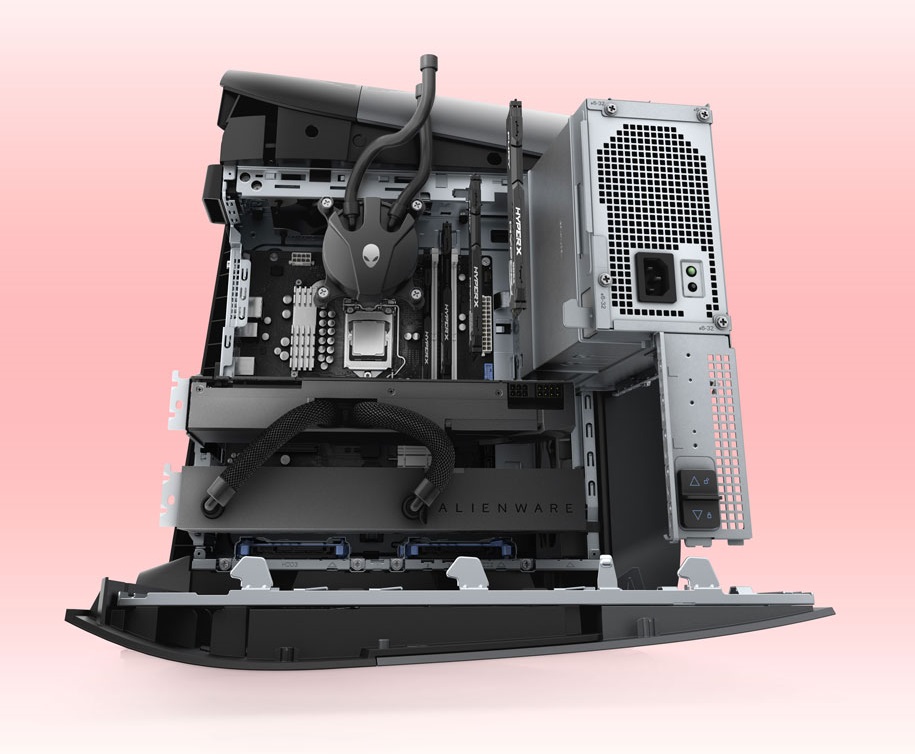Alienware Aurora R11 Has the Weirdest Liquid GPU Loop We've Ever Seen
A radiator in the PCIe slot? You saw that right.
Just yesterday Alienware announced its new machines, among which the Aurora R11 gaming desktop that comes with liquid cooling. We hadn't noticed at the time, but as tweeted by Asetek, it looks like the GPU will be liquid-cooled with a radiator built into a PCI-Express slot below the graphics card, which Asetek is calling the Rad Card.
We've seen some creative solutions to build GPUs into AIO loops, but this is something we haven't seen before, and is certainly even more unusual than what AMD did with its Radeon R9 Fury X.

According to Asetek, this setup reduces noise by 69% and temperatures by 20%. In the tweet thread, Asetek also explained that the Rad Card draws its power and fan curves from the GPU, which makes it extremely easy to operate.
However, Asetek made the decision to use blower-style coolers. For the graphics card itself, we can understand as after cooling the GPU externally, the blower doesn't need to do much work to keep the memory and VRMs cool. However, for the GPU, we would imagine that the blower on the Rad Card would still have to do quite a bit of work to dissipate the heat. Of course, the Alienware Aurora R11's chassis doesn't lend itself to huge amounts of airflow, so this might be the only way to effectively extract the heat buildup from the case.
That being said, the finish looks quite nice, and all the fan cables are integrated neatly into the sleeves of the liquid cooling hoses, creating a very clean appearance.
For the time being, Asetek is only providing the Rad Card solution to Alienware, which is currently only using the solution for an RTX 2080 Super, but did mention that it is always listening to the community. So, do you think this should become something available freely on the DIY market?
Get Tom's Hardware's best news and in-depth reviews, straight to your inbox.
Niels Broekhuijsen is a Contributing Writer for Tom's Hardware US. He reviews cases, water cooling and pc builds.
-
grimfox Well now, I want to see a rad that you can integrate into a 2-4x serial liquid cooling GPU connection. Imagine a dual GPU setup where you can slot a rad into the gap between the cards. I doubt the performance would be much better than adding a 120 rad to the loop, but it would look super clean. Which is all the more reason to make one, imo.Reply -
PapaCrazy Wait a second... what if... (takes another puff)... they made the whole case a giant radiator...Reply -
Asetek_shawn Reply
Hey Tom's Community! We're stoked, you're stoked about the new Asetek Rad Card. It's pretty slick!Admin said:The Rad card is a PCIe-based radiator that we're seeing first in the Alienware Aurora R11.
Alienware Aurora R11 Has the Weirdest Liquid GPU Loop We've Ever Seen : Read more
But we wanted to remind everyone, the quoted performances #s are strictly relative to the Alienware Lunar Light chassis environment. ;) -
Gillerer When someone starts measuring temperatures in percentages, you know they don't know what they're talking about. Percentages only make any sense for temperatures if talking about absolute temperature and the heat energy contained - otherwise it's pure marketing trickery.Reply
Would have thought better of Asetek, but I suppose it's attributable to their marketing department, or a PR company.
TH isn't doing its due diligence when it disseminates these kinds of releases without calling attention to bad statements. -
soniccd so the gpu itself is mounted on one slot , and the radiator+ pump on another slot ? similar to this though https://ibb.co/x10qDdQReply -
asetekdennis ReplyGillerer said:When someone starts measuring temperatures in percentages, you know they don't know what they're talking about. Percentages only make any sense for temperatures if talking about absolute temperature and the heat energy contained - otherwise it's pure marketing trickery.
Would have thought better of Asetek, but I suppose it's attributable to their marketing department, or a PR company.
TH isn't doing its due diligence when it disseminates these kinds of releases without calling attention to bad statements.
We're more than happy to disclose actual temperatures. Absolutely no secrets :)
The reason we've chose percentage changes is that we're comparing up against the former GPU Blower card that Alienware used, in their chassis.
Numbers aren't totalitarian, so you'll get different actual numbers depending on cases and setups. What we decided to do is eliminate that and focus on a strict A/B scenario.
I'm also pretty sure that there will be more content (from Alienware and Ourselves) on the Rad Card in the near future :)
soniccd said:so the gpu itself is mounted on one slot , and the radiator+ pump on another slot ? similar to this though https://ibb.co/x10qDdQ
It is similar. Though without touting our own horn, slightly more advanced :)
Pump is in the coldplate (ie. on the GPU) and the radiator and fan for the rad on the actual Rad Card. -
Math Geek what an interesting idea. never really thought of such a thing as this.Reply
if it manages to get out into the wild could be interesting to work with. for now, pics will have to be enough as i won't be buying this pc just for the novel cooling technique. :) -
soniccd Replyasetekdennis said:We're more than happy to disclose actual temperatures. Absolutely no secrets :)
The reason we've chose percentage changes is that we're comparing up against the former GPU Blower card that Alienware used, in their chassis.
Numbers aren't totalitarian, so you'll get different actual numbers depending on cases and setups. What we decided to do is eliminate that and focus on a strict A/B scenario.
I'm also pretty sure that there will be more content (from Alienware and Ourselves) on the Rad Card in the near future :)
It is similar. Though without touting our own horn, slightly more advanced :)
Pump is in the coldplate (ie. on the GPU) and the radiator and fan for the rad on the actual Rad Card.
i see , saw that card on an ebay listing , then this article pops up .. was going ,hmm like seen this concept before .. -
jmcgaw ReplyPapaCrazy said:Wait a second... what if... (takes another puff)... they made the whole case a giant radiator...
Or they could go all Cray on it and fill the whole bloody computer with cooling fluid and just pump that around through a refrigeration unit. Old, proven tech. -
PapaCrazy Replyjmcgaw said:Or they could go all Cray on it and fill the whole bloody computer with cooling fluid and just pump that around through a refrigeration unit. Old, proven tech.
Hm, that's interesting. Wonder if someone could jimmy-rig that with an aquarium PC. Kind of reminds me of an attempt by Microsoft to put servers under ocean water. Tides supply a perfectly reliable pump system and free energy... speaking of old, proven tech.
